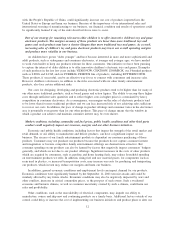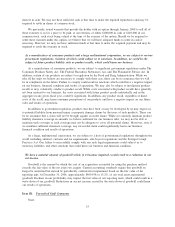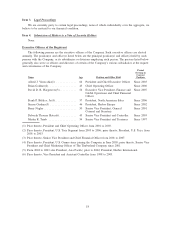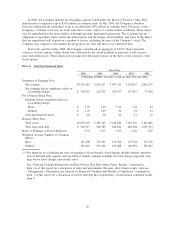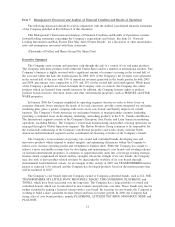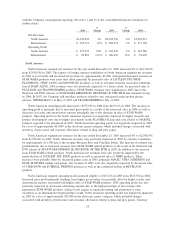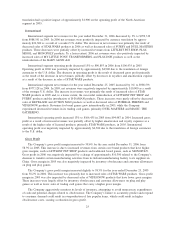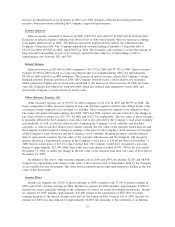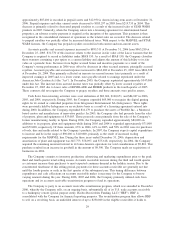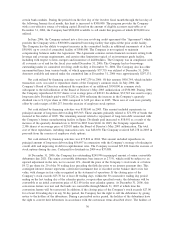Hasbro 2006 Annual Report Download - page 32
Download and view the complete annual report
Please find page 32 of the 2006 Hasbro annual report below. You can navigate through the pages in the report by either clicking on the pages listed below, or by using the keyword search tool below to find specific information within the annual report.
Item 7. Management’s Discussion and Analysis of Financial Condition and Results of Operations
The following discussion should be read in conjunction with the audited consolidated financial statements
of the Company included in Part II Item 8 of this document.
This Management’s Discussion and Analysis of Financial Condition and Results of Operations contains
forward-looking statements concerning the Company’s expectations and beliefs. See Item 1A “Forward-
Looking Information and Risk Factors That May Affect Future Results” for a discussion of other uncertainties,
risks and assumptions associated with these statements.
(Thousands of Dollars and Shares Except Per Share Data)
Executive Summary
The Company earns revenue and generates cash through the sale of a variety of toy and game products.
The Company sells these products both within the United States and in a number of international markets. The
Company’s business is highly seasonal with a significant amount of revenues occurring in the second half of
the year and within that half, the fourth quarter. In 2006, 68% of the Company’s net revenues were generated
in the second half of the year with 35% of annual net revenues generated in the fourth quarter. In both 2005
and 2004, percentages were comparable at 67% and 35% for the second half and fourth quarter. While many
of the Company’s products are based on brands the Company owns or controls, the Company also offers
products which are licensed from outside inventors. In addition, the Company licenses rights to produce
products based on movie, television, music and other entertainment properties, such as MARVEL and STAR
WARS properties.
In January 2006 the Company simplified its operating segment structure in order to better focus on
consumer demands, better anticipate the needs of its retail customers, provide a more integrated toy and game
marketing plan, place a greater company-wide focus on its core brands and thereby improve its overall
business. The Company’s North American toy and games business is managed under common leadership,
providing a combined focus on developing, marketing, and selling products in the U.S., Canada and Mexico.
The International segment consists of the Company’s European, Asia Pacific and Latin American marketing
operations, excluding Mexico. The Company’s world-wide manufacturing and product sourcing operations are
managed through its Global Operations segment. The Hasbro Products Group continues to be responsible for
the world-wide outlicensing of the Company’s intellectual properties and works closely with the North
American and International segments on the coordinated out-licensing activities of the Company’s brands.
The Company’s focus remains on growing core owned and controlled brands, developing new and
innovative products which respond to market insights, and optimizing efficiencies within the Company to
reduce costs, increase operating profits and strengthen its balance sheet. While the Company has sought to
achieve a more sustainable revenue base by developing and maintaining its core brands and avoiding reliance
on licensed entertainment properties, it continues to opportunistically enter into or leverage existing strategic
licenses which complement its brands and key strengths. Given the strength of its core brands, the Company
may also seek to drive product-related revenues by increasing the visibility of its core brands through
entertainment-based theatrical venues. As an example of this, in July of 2007, the TRANSFORMERS motion
picture is expected to be released and the Company has developed products based on the motion picture that
will be marketed in 2007.
The Company’s core brands represent Company-owned or Company-controlled brands, such as G.I. JOE,
TRANSFORMERS, MY LITTLE PONY, MONOPOLY, MAGIC: THE GATHERING, PLAYSKOOL and
TONKA, which have been successful over the long term. The Company has a large portfolio of owned and
controlled brands, which can be introduced in new formats and platforms over time. These brands may also be
further extended by pairing a licensed concept with a core brand. By focusing on core brands, the Company is
working to build a more consistent revenue stream and basis for future growth. In 2006, the Company had
strong sales of core brand products, namely PLAYSKOOL, LITTLEST PET SHOP, MONOPOLY, NERF, and
PLAY-DOH.
21



